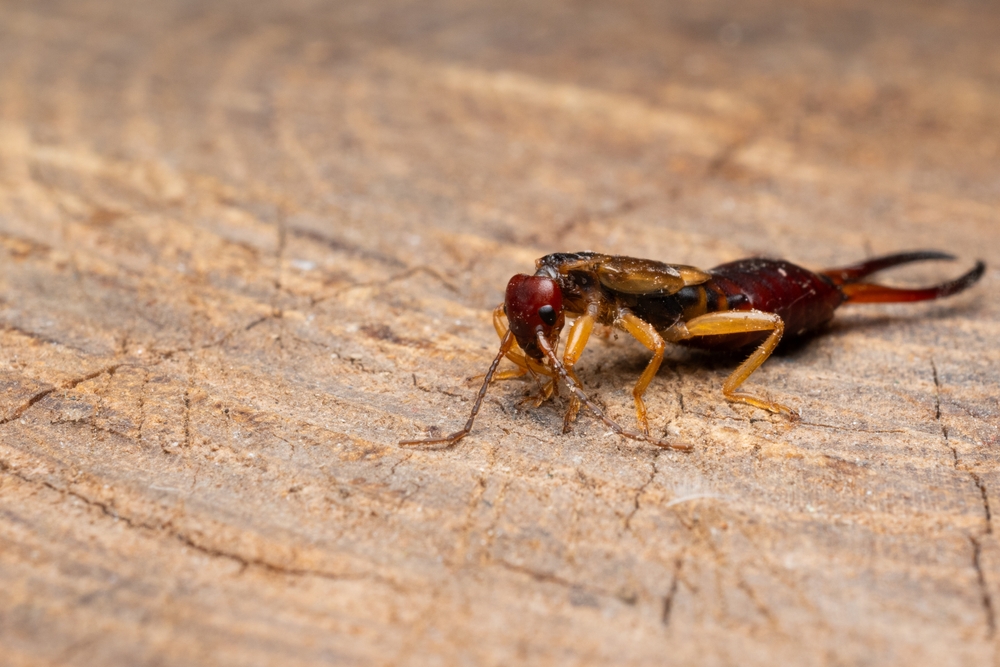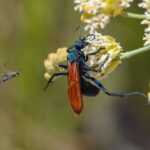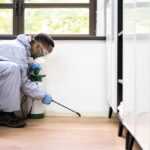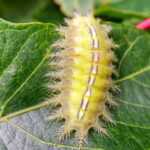Earwig Bug Control: Effective Tips and Solutions
Discover effective tips and solutions for earwig bug control to protect your home. Learn practical methods to keep these pests at bay. Read more now!
Earwig Bug Facts, Identification, and Prevention Tips
Earwig bugs are common but often misunderstood insects. This guide explores what they are, if they are harmful, and how you can manage or prevent an infestation in your home and garden.
- Earwigs play a role in organic material decomposition, aiding soil health, yet they can be nuisances in homes and gardens due to their feeding habits.
- Understanding earwig species, life cycles, and feeding behaviors is crucial for effective management and control of their populations.
- Preventative measures, including sealing entry points and reducing moisture, alongside DIY methods like traps and natural repellents, can effectively manage earwig infestations.
Understanding Earwigs
Earwigs are fascinating yet often misunderstood insects. Known for their distinctive pincers and elongated bodies, these nocturnal creatures are typically found in damp environments such as under lawn debris, mulch, and decaying wood, including areas where dead insects may accumulate. Despite their intimidating appearance, earwigs play a role in breaking down organic material and contributing to soil health. However, their tendency to invade homes and gardens makes them a common nuisance.
There are nearly 2,000 species of earwigs globally, each exhibiting unique behaviors and characteristics. Knowledge of earwig species, their life cycles, and feeding habits aids in effective management and control.
What Are Earwigs?
Earwigs are small insects that primarily live outdoors, characterized by their intimidating appearance with pincers. Most earwigs possess one set of wings, typically hidden under hard covers, but they rarely fly. Male earwig pincers are long and curved, while female pincers are shorter and straighter, used mainly for defense and capturing prey.
They thrive in dark, damp environments, often found under lawn debris, mulch, and decaying wood. They are nocturnal and semi-social, often found in groups during the day. Despite their fearsome appearance, earwigs are relatively harmless to humans and do not pose significant health risks.
The name ‘earwig’ originates from an old myth suggesting that these insects crawl into human ears, which is highly unlikely due to the lack of food and moisture in such environments. Recognizing their true nature dispels myths and facilitates effective management.
Types of Earwigs
Earwig species are diverse, found on every continent except Antarctica. The European earwig and ring-legged earwigs are among the many earwig species, known for their rare use of wings. The European earwig, in particular, is prevalent in many regions and measures between 12 to 15 mm long. European earwigs are an important part of the ecosystem.
The Saint Helena earwig, discovered on St. Helena, stands out due to its impressive size, nearly three times longer than most other earwig species. In contrast, seashore earwigs, with their dark brown bodies and yellow legs, are typically found along coastal regions.
Striped earwigs, characterized by their tan and dark brown color with two vertical stripes on their thorax, measure about 25 mm (1 inch) and are commonly found in various habitats. This diversity among earwig species highlights the adaptability and varied ecological roles they play.
Life Cycle of Earwigs
The life cycle of earwigs begins in early spring when female earwigs lay eggs between 20 to 60 earwig eggs, which typically hatch within a week. Female earwigs exhibit maternal care by protecting the eggs and looking after the nymphs until they can fend for themselves. This maternal behavior is quite unique among insects and contributes to the survival of young earwigs.
Once the eggs hatch, the nymph stage begins, characterized by several molts. It typically takes four to six molts for the nymphs to reach adulthood, growing larger and developing adult features with each molt. Adult earwigs, once mature, generally have a lifespan of about one year.
Earwigs usually mate in the fall or early winter, indicating a seasonal pattern in their reproductive habits. Comprehending the earwig life cycle aids in targeting the right stages for effective intervention and control.
Earwig Feeding Habits
Earwigs are omnivorous scavengers, consuming both plant and animal matter. Their diet includes decaying plant material and other insects, which aids in nutrient recycling and soil health. Though beneficial in some contexts, their feeding behavior can cause issues in gardens and homes.
In gardens, earwigs can damage plants by creating small, ragged holes in the tissue of fruits and vegetables. Indoors, they seek out decaying plant matter and organic materials, sometimes contaminating food and household items. Knowing their feeding habits is essential for effective population management.
What Do Earwigs Eat?
Earwigs have an omnivorous diet, feeding on a variety of organic materials. In gardens, they primarily target various garden plants, contributing to potential damage. Seashore earwigs, for example, commonly feed on other insects such as ants and fleas.
When indoors, earwigs typically seek out vegetable waste and can consume items like flour and cookies. This opportunistic feeding behavior allows them to thrive in different environments, making them versatile but unwelcome guests.
Impact on Gardens
Earwigs are commonly recognized as pests in home gardens due to their potential to damage seedlings and soft fruits. They can inflict significant damage on young plants, particularly during their growth stages, including immature earwigs. If you notice earwigs, this can lead to reduced crop yields and compromised plant health.
The presence of earwigs in gardens often results in small, ragged holes in plant tissue, indicating their feeding behavior. Managing earwig populations in gardens is essential to protect plants and ensure healthy growth.
Indoor Feeding
When earwigs invade homes, they tend to consume decaying plant matter and organic materials. Common indoor food sources for earwigs include dry pantry goods like grains and cereals. This feeding behavior can lead to contamination of food and deterioration of household items.
Identifying what earwigs eat indoors helps remove potential food sources, reducing their attraction to homes.
Earwigs as Pests
Earwigs are often considered nuisances both indoors and outdoors due to their presence in gardens and homes. Despite their intimidating appearance, earwigs are relatively harmless to humans, causing minimal threat. However, their role as pests stems from their feeding habits and potential to damage plants and contaminate food.
Tackling an earwig infestation involves grasping their behavior, identifying entry points, and implementing effective control measures. This section will explore their impact as household and garden pests and debunk common myths about them.
Household Pests
Earwigs are attracted to homes by light, rain, and dry hiding places, often leading them to enter during rainy conditions. They can find their way into buildings through cracks or crevices. Once indoors, earwigs typically hide in cracks and crevices near a water source, commonly in kitchens and bathrooms.
Although they rarely enter homes in large numbers, seeing one indoors suggests there may be nesting occurring in the surrounding soil. Earwigs can pinch humans, but their pinch is weak and typically leaves only a small red mark that heals quickly. In homes, individual earwigs do not live long, making their presence often temporary.
Control earwigs at home by vacuuming and sweeping them up, then sealing any entry cracks. If earwigs infest your home, it is advisable to contact a licensed pest control company for assistance.
Garden Pests
Earwigs can cause significant harm to soft fruits and vulnerable seedlings. They can damage plant leaves and flowers. Observing earwigs at night with a flashlight can help confirm if they are damaging plants.
While earwigs usually do not cause enough damage to be worth fighting, their presence in gardens can still be problematic. Managing their populations helps protect plants and ensure healthy growth.
Myths and Misconceptions
The name ‘earwig’ originated from a myth suggesting that these insects crawl into human ears. While it is theoretically possible for earwigs to crawl into human ears, it is unlikely due to their lack of food and moisture in such environments.
Earwigs do not pose a threat to humans, as they do not spread diseases. Dispelling these myths aids in more effective management of earwig infestations.
Preventing and Controlling Earwig Infestations
Preventing and controlling earwig infestations involves a combination of proactive measures and targeted interventions. Seal entry points, reduce moisture, remove hiding spots, and manage garden debris to prevent earwigs. Homemade solutions for earwig control can be effective without the use of harsh chemicals. DIY methods can help manage earwig populations but may not fully resolve infestations.
Understanding these strategies and when to seek professional help ensures effective management of earwig infestations.
Preventing Earwigs Indoors
Seal cracks and entry points to keep earwigs out of homes. Dehumidifiers inside your home can deter earwigs by reducing moisture. A vapor barrier in crawlspaces reduces moisture and deters earwig infestations.
Earwigs may invade homes when external conditions are too hot, dry, or cold. Keeping earwigs out of homes is vital for a pest-free environment.
Controlling Earwigs Outdoors
Eliminating debris and maintaining dry landscaping can help control earwig populations in gardens. Clear fallen leaves and plant debris from gardens to minimize earwig habitats. Traps can significantly reduce earwig numbers in outdoor settings.
A trap can be made by rolling up corrugated cardboard and tying it near tree trunks. Encourage beneficial predators like birds and toads to naturally reduce earwig populations.
Professional Pest Control
When DIY methods fall short, professional pest control services can provide tailored strategies for effective earwig management. Consulting with pest control experts ensures a thorough approach to preventing earwig infestations.
DIY Methods for Reducing Earwig Numbers
For those who prefer a hands-on approach, DIY methods can effectively help in managing earwig populations in gardens and homes. Homemade traps and natural repellents offer simple, effective solutions for reducing earwig numbers without harsh chemicals.
Regularly check and maintain these traps to ensure effectiveness, and combine methods to increase success in managing earwig threats.
Trapping Earwigs
One effective way to trap earwigs is by using rolled-up newspapers, which can attract and capture these pests. Place these traps in common earwig areas like gardens or damp spots in your home to significantly reduce their numbers.
Regularly check and dispose of captured earwigs to maintain trap effectiveness. This method is simple, cost-effective, and can be an excellent first step to get rid of earwigs in your earwig control efforts.
Natural Repellents
Soapy water can be used as a natural repellent to deter earwigs, providing an eco-friendly solution to manage these pests. A dish soap and water mixture creates an effective homemade repellent when sprayed on plants or infested areas.
Additionally, essential oils like peppermint and citronella can help repel earwigs when used in a diluted spray. These natural solutions deter earwigs and add a pleasant scent to your garden or home.
Combining Methods
Utilizing multiple pest control strategies increases the likelihood of effectively managing earwig populations. Combining traps and natural repellents can enhance the effectiveness of your earwig management plan.
Integrating methods like sealing entry points, reducing moisture, and using homemade traps and repellents yields better results in managing earwig threats. This comprehensive approach ensures you address the problem from multiple angles, leading to more sustainable pest control.
Understanding earwigs, from their biology and feeding habits to their impact as pests, is essential for effective management. These nocturnal insects, while beneficial in some contexts, can cause significant damage to gardens and contaminate food in homes. By identifying different earwig species and their life cycles, you can better tailor your control strategies to target these pests at the right stages.
Preventing and controlling earwig infestations involves a combination of proactive measures, DIY methods, and professional pest control services. Whether you choose to set traps, use natural repellents, or seek expert assistance from companies like Responsible Pest & Scorpion Control, being informed and prepared is key to maintaining a pest-free environment. Take action today to protect your home and garden from earwig infestations.
Frequently Asked Questions
What attracts earwigs?
Earwigs are primarily attracted to moisture, as they thrive in damp conditions. Reducing humidity in your environment can help prevent their presence.
Should you kill earwigs?
Killing earwigs is generally unnecessary, as they do not harm or damage your home. Instead, you can simply collect and discard them if they become a nuisance.
What areas does Responsible Pest & Scorpion Control serve?
Responsible Pest & Scorpion Control serves the Greater Metro Phoenix area, as well as Mesa and Tucson in Arizona.
What type of services does Responsible Pest & Scorpion Control offer for residential properties?
Responsible Pest & Scorpion Control provides residential pest control services, focusing on the effective management of various pests, including scorpions and earwigs. Their expertise ensures a pest-free environment for your home.
What does Responsible Pest & Scorpion Control guarantee for their services?
Responsible Pest & Scorpion Control guarantees effective pest and scorpion control services at affordable prices. Clients can expect reliable solutions that meet their needs.



